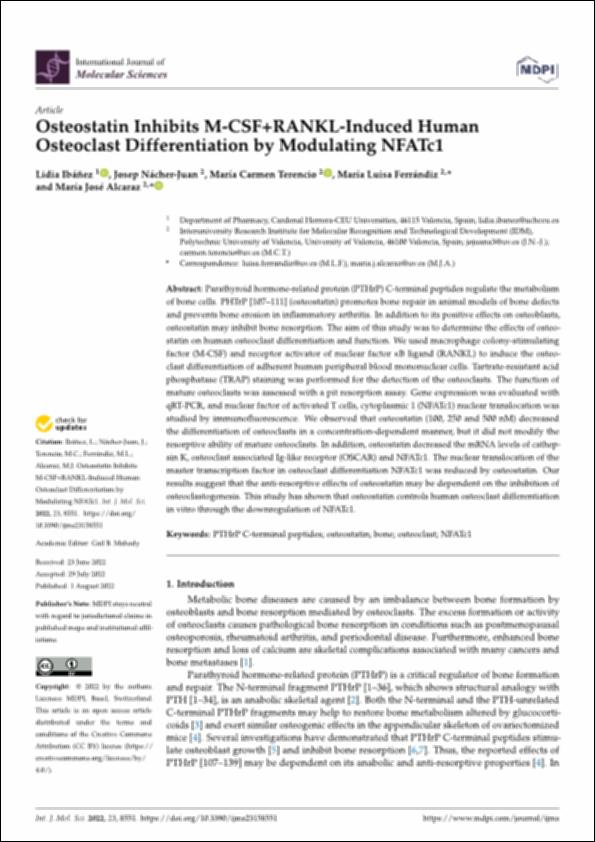Please use this identifier to cite or link to this item:
http://hdl.handle.net/10637/14409Osteostatin inhibits M-CSF plus RANKL-induced human osteoclast differentiation by modulating NFATc1
| Title: | Osteostatin inhibits M-CSF plus RANKL-induced human osteoclast differentiation by modulating NFATc1 |
| Authors : | Ibáñez Torres, Lidia Nácher Juan, Josep Terencio Silvestre, María Carmen Ferrándiz Manglano, María Luisa Alcaraz Tormo, María José |
| Keywords: | Péptidos.; Bones - Regeneration.; Peptides.; Huesos - Regeneración.; Cell metabolism.; Artritis - Tratamiento.; Células - Metabolismo.; Arthritis - Treatment. |
| Publisher: | MDPI |
| Citation: | Ibáñez, L., Nácher-Juan, J., Terencio, M. C., Ferrándiz, M. L. & Alcaraz, M. J. (2022). Osteostatin inhibits M-CSF+RANKL-induced human osteoclast differentiation by modulating NFATc1. International Journal of Molecular Sciences, vol. 23, i. 15 (01 aug.), art. 8551. DOI: https://doi.org/10.3390/ijms23158551 |
| Abstract: | Parathyroid hormone-related protein (PTHrP) C-terminal peptides regulate the metabolism of bone cells. PHTrP [107–111] (osteostatin) promotes bone repair in animal models of bone defects and prevents bone erosion in inflammatory arthritis. In addition to its positive effects on osteoblasts, osteostatin may inhibit bone resorption. The aim of this study was to determine the effects of osteostatin on human osteoclast differentiation and function. We used macrophage colony-stimulating factor (M-CSF) and receptor activator of nuclear factor B ligand (RANKL) to induce the osteoclast differentiation of adherent human peripheral blood mononuclear cells. Tartrate-resistant acid phosphatase (TRAP) staining was performed for the detection of the osteoclasts. The function of mature osteoclasts was assessed with a pit resorption assay. Gene expression was evaluated with qRT-PCR, and nuclear factor of activated T cells, cytoplasmic 1 (NFATc1) nuclear translocation was studied by immunofluorescence. We observed that osteostatin (100, 250 and 500 nM) decreased the differentiation of osteoclasts in a concentration-dependent manner, but it did not modify the resorptive ability of mature osteoclasts. In addition, osteostatin decreased the mRNA levels of cathepsin K, osteoclast associated Ig-like receptor (OSCAR) and NFATc1. The nuclear translocation of the master transcription factor in osteoclast differentiation NFATc1 was reduced by osteostatin. Our results suggest that the anti-resorptive effects of osteostatin may be dependent on the inhibition of osteoclastogenesis. This study has shown that osteostatin controls human osteoclast differentiation in vitro through the downregulation of NFATc1. |
| Description: | Este artículo se encuentra disponible en la siguiente URL: https://www.mdpi.com/1422-0067/23/15/8551 Este artículo de investigación pertenece al número especial "Peptides for Health Benefits 2021". |
| URI: | http://hdl.handle.net/10637/14409 |
| Rights : | http://creativecommons.org/licenses/by/4.0/deed.es |
| ISSN: | 1422-0067 (Electrónico) |
| Language: | es |
| Issue Date: | 1-Aug-2022 |
| Center : | Universidad Cardenal Herrera-CEU |
| Appears in Collections: | Dpto. Farmacia |
Items in DSpace are protected by copyright, with all rights reserved, unless otherwise indicated.


